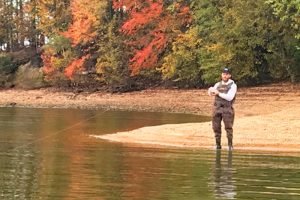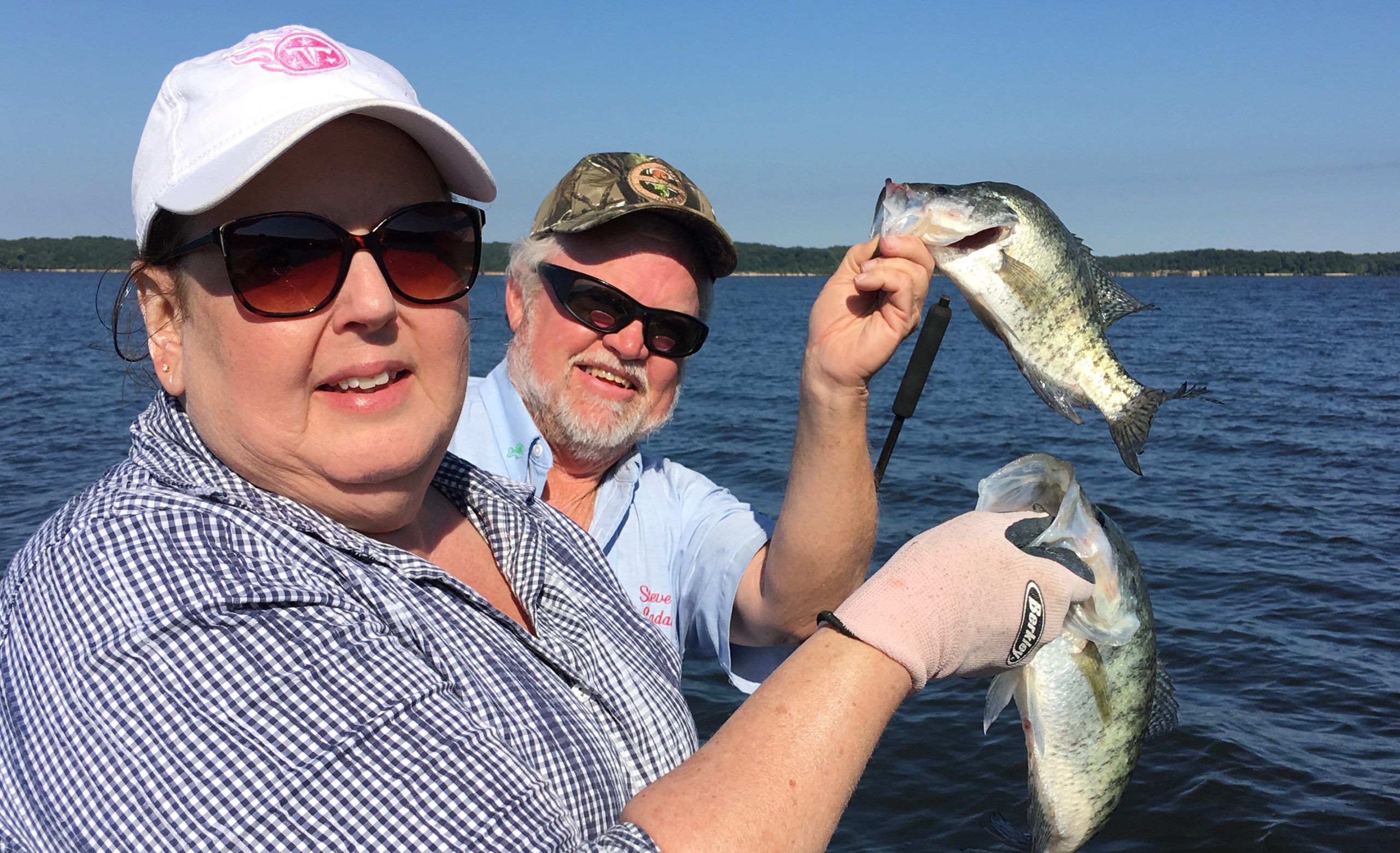Steve McCadams shows off a slab caught during the October “transition period” as air
and water temperatures begin to moderate, often inspiring crappie to become more aggressive.
Catching Crappie in Transition
by Steve McCadams
For the lion’s share of the crappie world, it has been a hot and dry summer. In the South we have experienced way too many days with a triple-digit heat index.
Enough already!
We’re all ready for the change of seasons, a nip in the air and an aggressive thump on the jig. Transition time is here as water temperatures drop, raising the interest level for scores of fishermen anxious for autumn’s arrival. I know I am. Something about fall that puts pep in my step.
As surface water temperatures diminish, you’ll often see schools of shad meandering about and flicking the surface.
Hot on their trail are hungry crappie who, like their forage base, are discovering new comfort zones away from the deep summer hideouts. Add a cloudy rainy day to the canopy and it gives a real boost to light-sensitive crappie that will pursue these baitfish buffets toward shallow venues.
Late afternoon and early morning ventures can be quite productive as it’s not unusual to see a flurry of activity during lowlight periods compared to a bright sun bearing down at midday.

color as the cooler, shorter days often inspire crappie to move shallow. It’s a fine time for bank
fishermen to explore key transition areas. (Photo: Steve McCadams)
Large reservoirs usually witness a slow stair-step pattern as fall kicks in. Weather conditions play a key role as early fall cold fronts can accelerate the pace at which both baitfish and crappie might make a shallow area blitz.
In smaller bodies of water, which cool off faster, fish are likely to move up quicker. Shallow bays or flats will begin producing fish fast whereas big reservoirs are a bit slower to witness the rapid temperature declines.
Crappie tend to leave deep main lake venues and meander their way to secondary bays and main lake flats or sandbars before reaching extremely shallow shorelines. A good test is to try the edge of main lake drop-offs such as 10-to-14 feet and slowly work up to the top sides of shallow ledges. Fish your way up to 5-to-8-foot zones.
Trial and error is the best approach when searching for that productive depth range. Sophisticated sonar units can become your bird dog, helping you establish specific locales for structure, baitfish schools and crappie activity.
Often times the abundance of baitfish can cloud your sonar screen, making it difficult to interpret clarity of isolated structure and scatted sightings of crappie that could be there but just not schooled up in any given spot.
Sometimes the crappie suspend and just follow the baitfish balls. Paying attention to the refuge of a discovered brushpile, stump or manmade fish attractor but realize there are times the fish are just roaming with the baitfish.
The best way to eliminate those unproductive submerged structures, unless you have fined tuned your sonar and really mastered its talents, is to knock on the doors. Sometimes the fish can play finicky, hiding tight to cover like a rabbit in the briar patch.

Other times, if they’re aggressive and competitive in a feeding frenzy then you won’t have to be a very good salesman to close the deal. Enter their comfort zone and stay on high alert. Odds are the fish will alert you to their whereabouts.
Whether you slow troll spider rig presentations, drag crankbaits, vertical fish single pole jigs or prefer casting light tackle with live minnows, or perhaps grubs, just consider exposing whatever baits you choose to the potential zone.
Fall crappie will often answer the call. That’s another feather in the cap for fall fishing as having to deal with a lot of variables is not often a problem.
One factor to consider is that flood control reservoirs experience an annual winter drawdown with water levels slowly being lowered. It’s done to create more storage capacity when heavy rains occur.
It’s a normal occurrence and while it doesn’t hurt the fishing scene, it does alter it and anglers best observe channel markers and boat cautiously in shallow zones, which may well be where the crappie are residing.
In some lakes with abundant stickups in the backwater bays or perhaps along shorelines, the mid-to-late fall crappie bite can be quite productive in 2-to-4-foot venues. Once the baitfish move up crappie will be right there with them and that shallow pursuit is something most anglers can relate to.
Dunking a jig or slip-bobber minnow presentation smack dab in the face of shallow crappie can be the cat’s meow. Fall crappie can turn aggressive and smack a bait once it enters their locale, resulting in some tackle testing hook sets and retrieves.
Fall crappie put on the feed bag and it really has something for all styles of anglers. From a deeper water finesse jig fishermen to a shallow water enthusiast, it’s all possible during fall.
Fighting fish instead of a crowd is yet another entry in the plus column. Boat ramps and fishing holes usually aren’t as crowded because many anglers head for the hunting woods or have just burned out on fishing for the year. Plus, the weatherman is usually kind to fall crappie stalkers.
Venture out on your favorite lakes frequently and be there for roll call. By logging time and effort, you’ll soon discover that you’ve been turning a blind eye to a wonderful fall fishing season that you’ve been overlooking.
Steve McCadams is a professional guide and outdoor writer from Paris, TN. At 70 years old, he’s been living and writing about the outdoors pretty much all this life. He holds a B.S. Degree in biology and has been Inducted into the National Freshwater Fishing Hall of Fame and Legends of the Outdoors. He shares a home with his wife Linda and their Labrador retriever, Avery.


